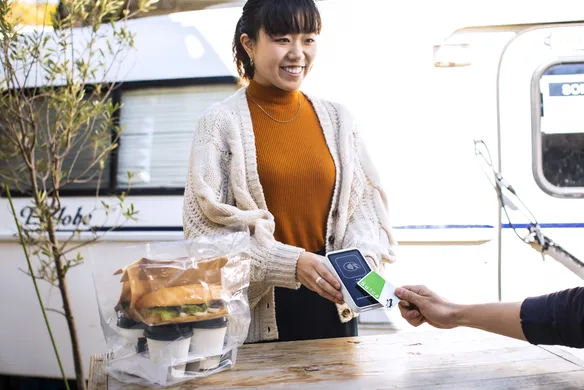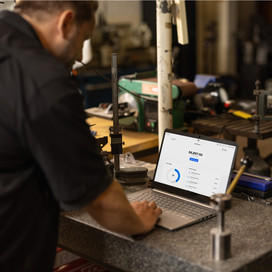Table of contents
While many small and traditional businesses fall by the wayside, pushed out of an evolving, compounding and increasingly tech-driven marketplace, the courier and delivery industry is arguably stronger than it has ever been – even for the smallest of players.
More and more people are buying online, a trend that has only been accelerated during COVID, as people traded trips to the mall for visits to eBay, Amazon, Uber Eats, Facebook Marketplace or any number of other ecommerce retailers and platforms. As it turned out, the overwhelming majority liked what they saw.
To a savvy entrepreneur, this all equates to a serious opportunity. It’s a chance to get into a thriving industry at a time when consumers are actively looking to help small and local companies succeed.
It might be time to start a courier business.
What is a courier business?
In the simplest terms, a courier business picks up goods from point A and delivers them to point B. Larger delivery and courier businesses have multiple drivers and channel goods through a central distribution centre, while smaller operations can offer fast and on-demand delivery services within a specified area, travelling directly between pick-up and drop-off points.
The capabilities of a courier business are bound to the vehicles it uses:
1. Bicycle or motorbike courier:
This option has the lowest barrier to entry – all you need is a bike – though it also has the lowest ceiling, as the amount of goods you can deliver at any one time is limited, and you’ll only be able to cover a (comparatively) small area.
2. Ute, van or truck courier:
A bigger vehicle will unlock economies of scale – both your capacity for goods and your delivery area will be larger, and you could begin to make multiple deliveries at once. The downside: the larger the vehicle, the higher the initial outlay.
3. Specialist courier:
Plenty of goods must be transported using specialist equipment, from pizzas and frozen food to medical equipment and hazardous materials. A specialist courier works within a specific niche, which can help to focus marketing efforts and maximise profits.
What do I need to start a courier business?
Wondering how to start a delivery business? To begin, let’s take a look at the things you’ll need before you open your doors.
1. Skills and knowledge
No formal training is required to open a basic courier business, though it is a job that demands a good level of strength and fitness, good time management and excellent organisational skills. If you are running your own business you’ll also need to be comfortable overseeing accounting, administration, customer service and people management.
2. A vehicle
Whether a bike or a truck, the size and shape of that vehicle is up to you, though the larger the vehicle, the larger the potential profits.
3. A driver’s licence
Ensure you have the appropriate licence for your chosen vehicle. Motorbikes and scooters demand a ‘Class R’ licence, the standard ‘Class C’ driver’s licence covers vehicles up to 4.5 tonnes, and any vehicle above that weight will require a specialised heavy vehicle licence.
4. Equipment
You may require any or all of the following items in order to run your courier business:
- A pallet truck or hand truck
- Cargo ropes, straps, nets and blankets
- Gloves, steel-capped shoes and a back brace
- A phone, tablet and/or laptop
5. Business Location
Whether a rented office or a spare room of your house, you’ll need a space to conduct business when you’re not on the road. If you intend to establish a distribution centre, you’ll need a place with plenty of space.
6. An ABN/ACN
By officially registering your venture with ASIC, you’ll be given an Australian business number (ABN) or an Australian company number (ACN). Whether you register as a sole trader, partnership, company or any other type of business will be guided by the shape of the business, the tax implications, and a variety of other considerations. It’s wise to get advice from a professional when you come to this stage.
7. Appropriate insurance
Things can go wrong through no fault of your own in business. You need to protect yourself against these adverse (and somewhat inevitable) events by taking out appropriate insurance. Begin by considering insurance that covers you, your vehicle, your office space and the goods you’re delivering.
8. Legal compliance
If you find yourself in unfortunate circumstances that aren’t covered by insurance, you need to ensure that you’ve dotted all the legal Is and crossed all the legal Ts. Work with a lawyer to develop airtight documentation around employment agreements, service agreements, and cancellation policies.
How to start a courier business in 9 simple steps
1. Set up shop
Set up a devoted office, whether in a spare room in your home or a dedicated space.
2. Identify your target market
You won’t compete with Australian Post or Uber Eats – at least for now – so it’s wise to start small and specialised. Work with a specific product, with a specific industry, or within a specific area.
3. Develop a business plan
Research the market to understand its size, your competitors, your costs, how much you should be charging, and where opportunities might lie.
4. Get the right vehicle, licence and equipment
Now that you know the basic shape of your courier business, find a vehicle to suit, and make sure you have the licence required to drive it and the equipment you’ll need to do the work.
5. Consider finance
If you don’t have the necessary capital to purchase all that you need, consider applying for a business loan for the necessary cash injection.
6. Ensure you’re covered
Both legally, through things like service agreements and cancellation policies, and against hiccups, with appropriate insurance.
7. Create your brand
Consult with a professional designer, and choose a business name and logo that is easily recognisable and is an accurate reflection of who you are and what you do.
8. Get the right tech
Implement business software that makes your life easier, including tools for:
- Delivery management
- Inventory management
- Invoicing and quoting
- Payroll and accounting
- Customer relationship management
- Point of sale system
- Payment solution
- Team management
9. Market your business:
Create social profiles for your brand, and build a website (that ideally offers customers the ability to book a pickup or delivery.) To find your first customers, cold call potential clients, hand out business cards, or consider joining a job marketplace like Airtasker or Hipages. Use paid digital marketing strategies to get your name out there, then use social proof and content marketing strategies to build your reputation in the market.
A courier business represents a unique opportunity. It can be whatever you want it to be, whether a perfectly entry-level opportunity that demands nothing more than a bike and a good level of fitness, or an ambitious operation that sees multiple vehicles working through a centralised distribution centre.
What’s more, the time couldn’t be more ripe, as COVID sees more people leaning on deliveries, as online shopping explodes, and as people look to actively support small, local businesses.
And if you’re ready to make the most of this unique alignment of stars, Square is ready to help.
![]()












